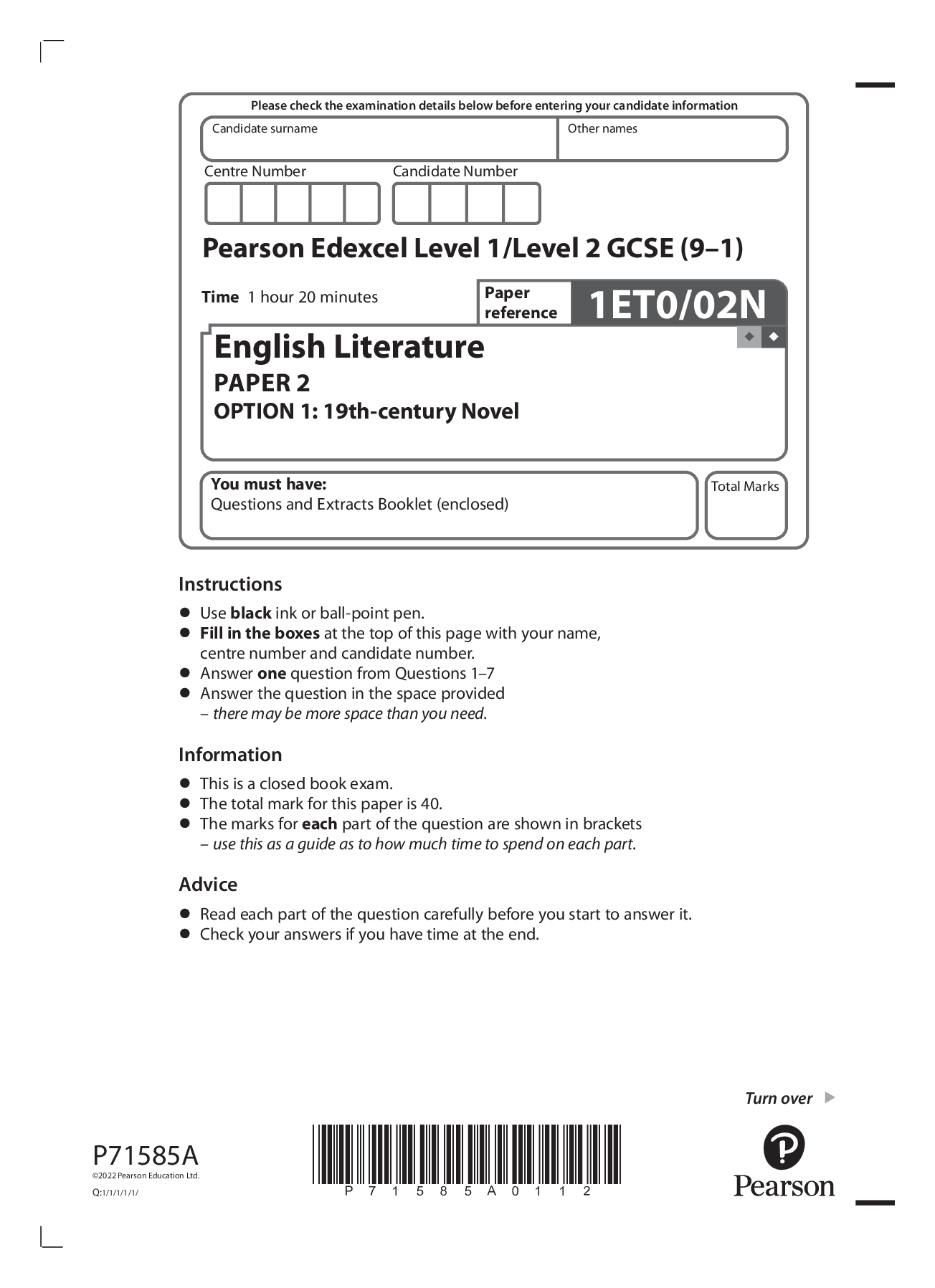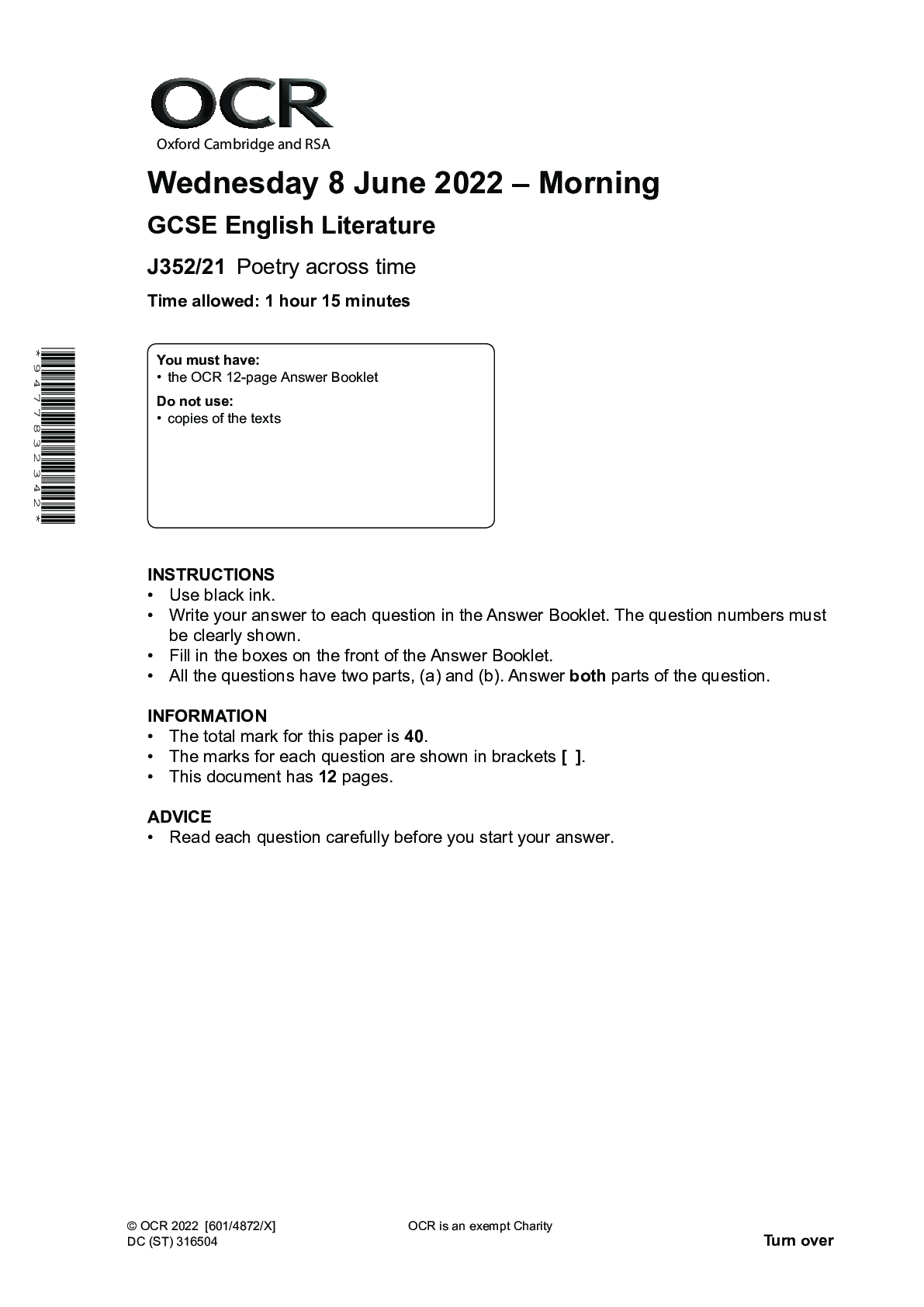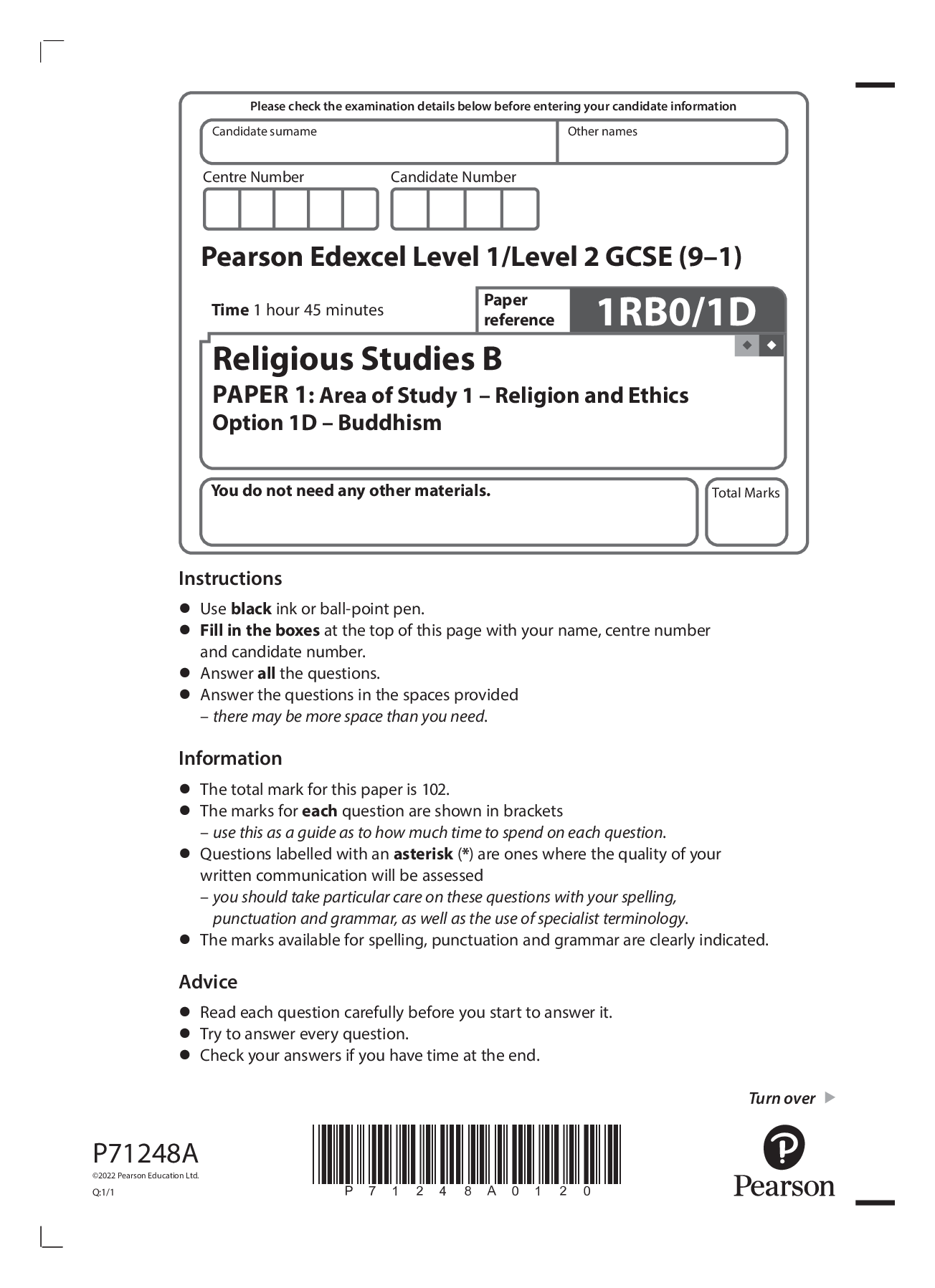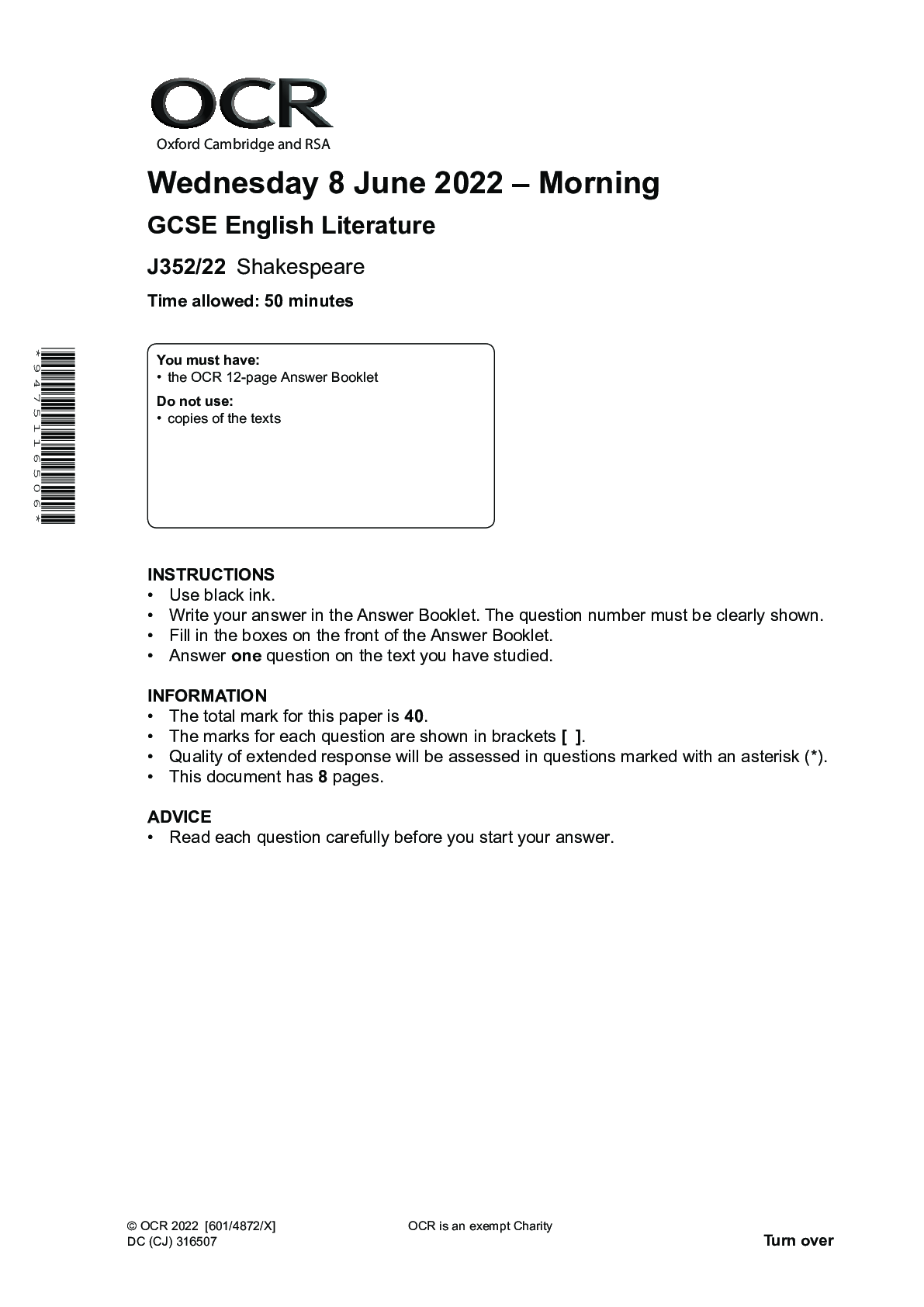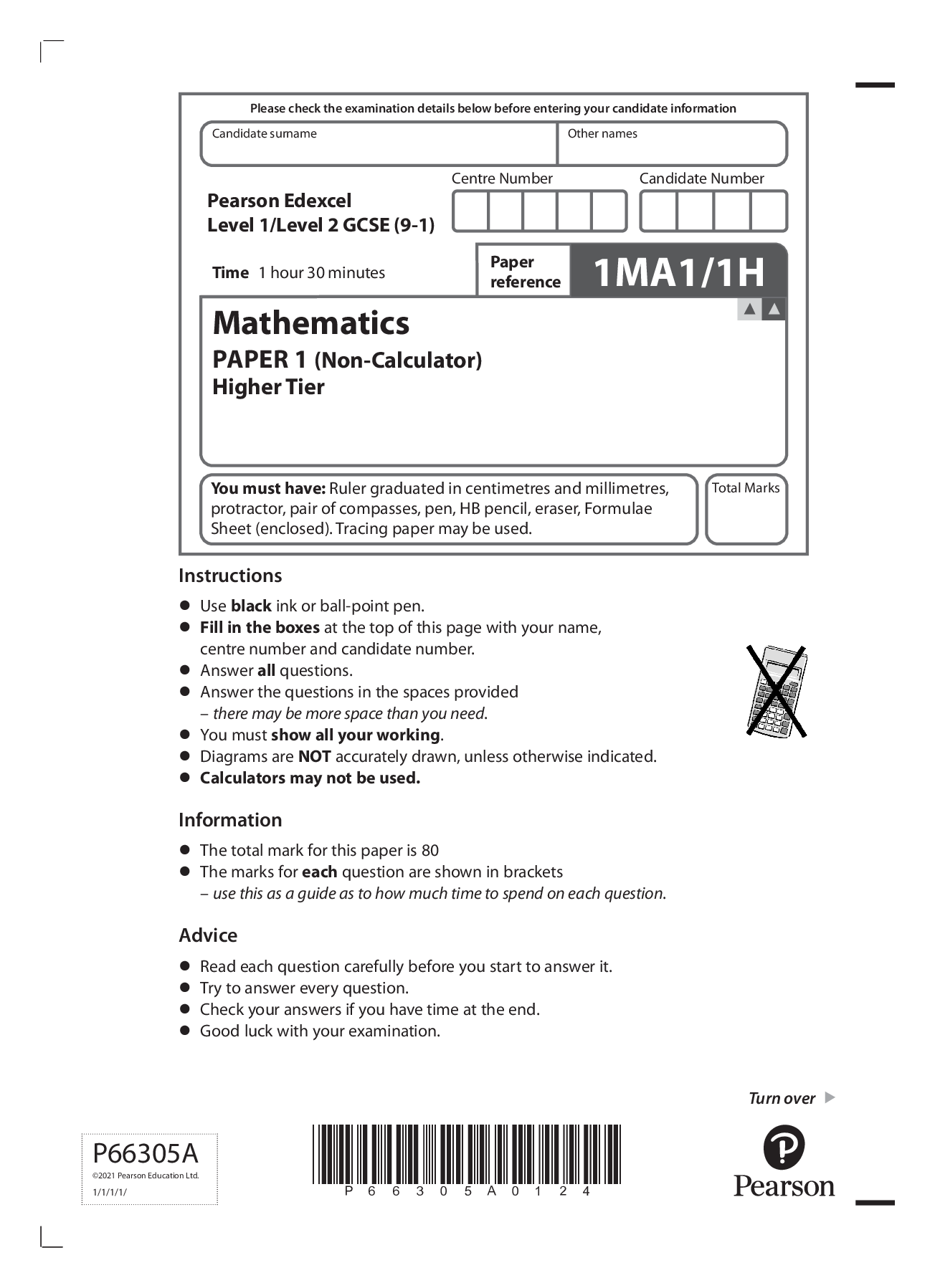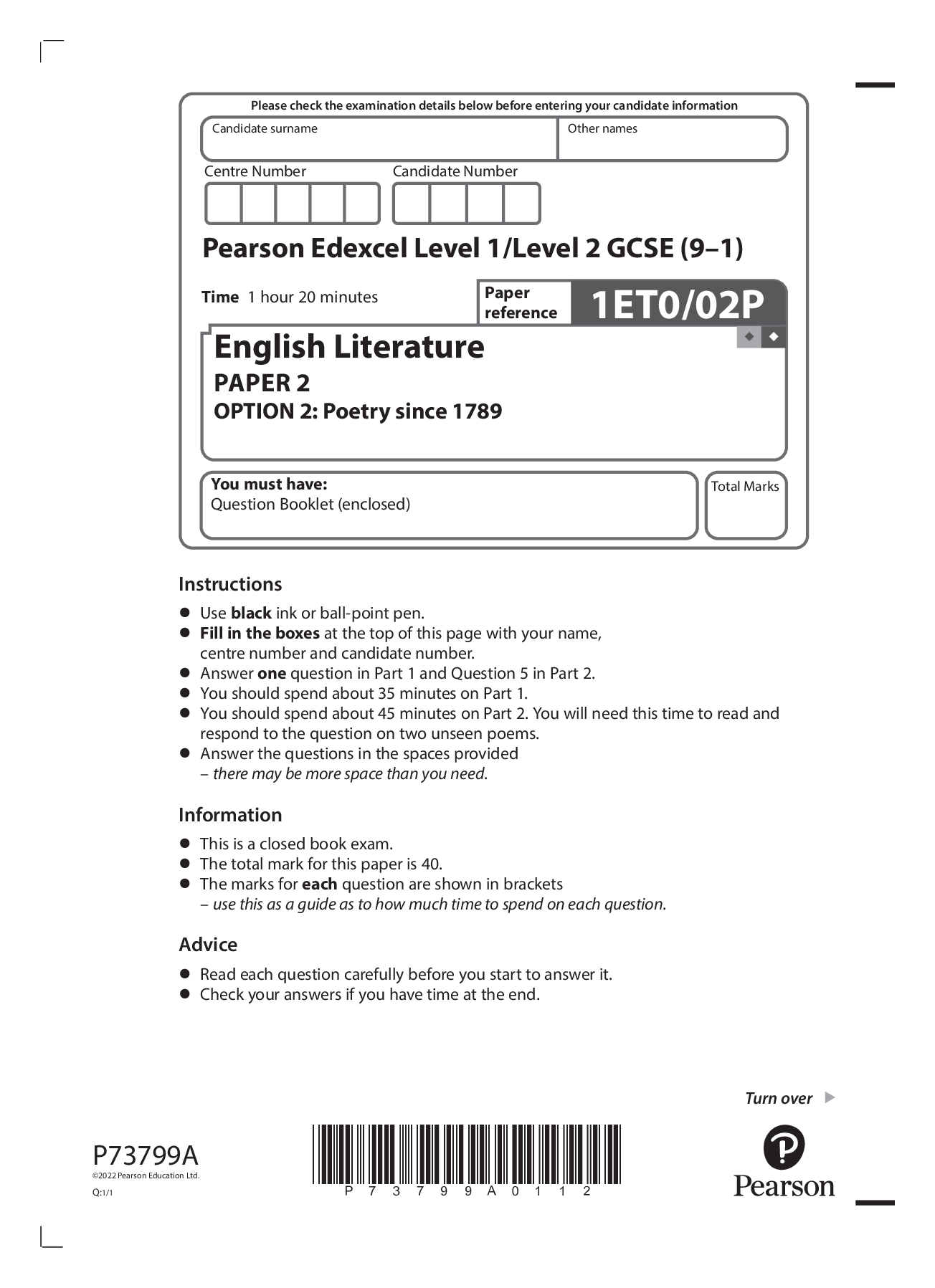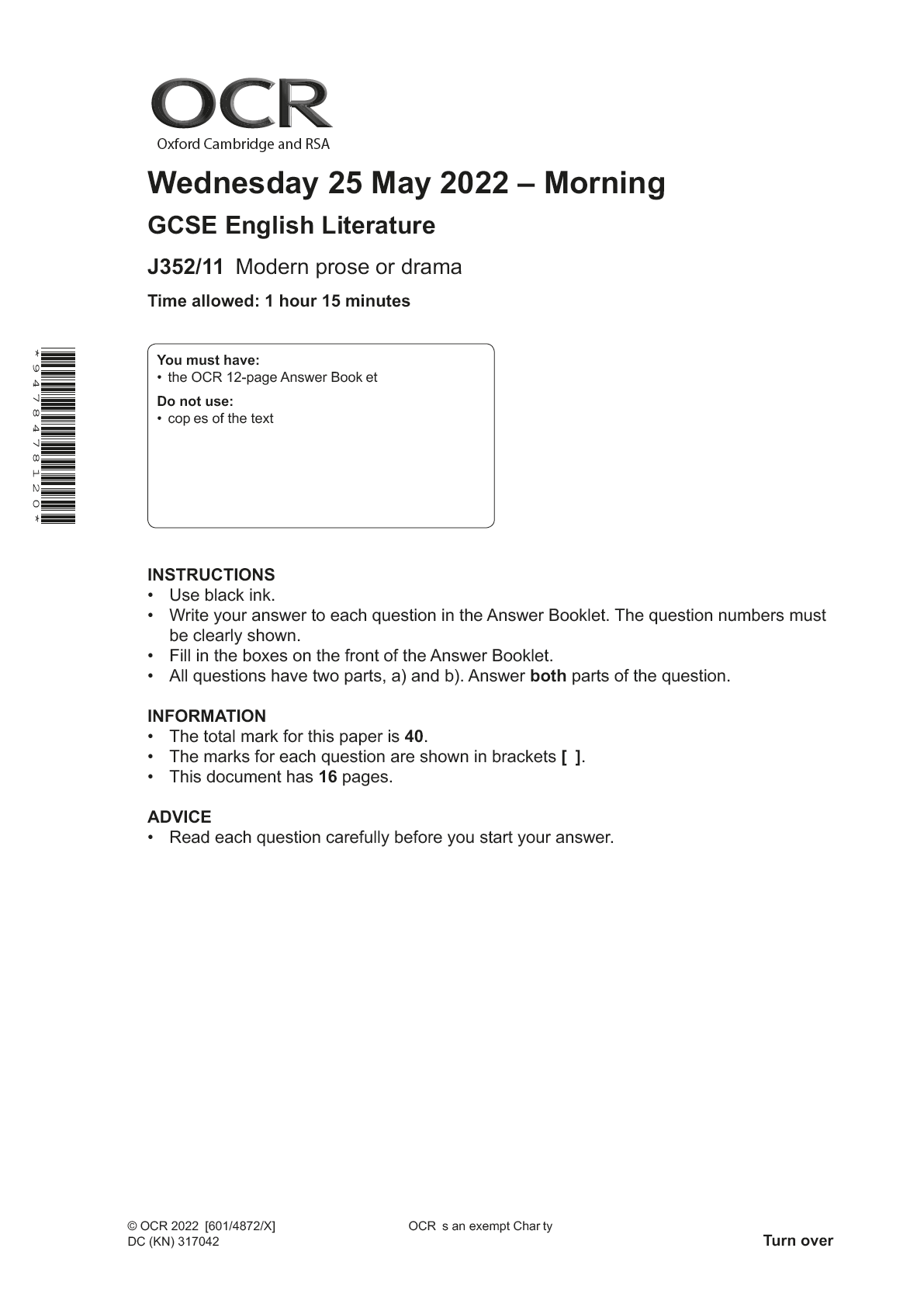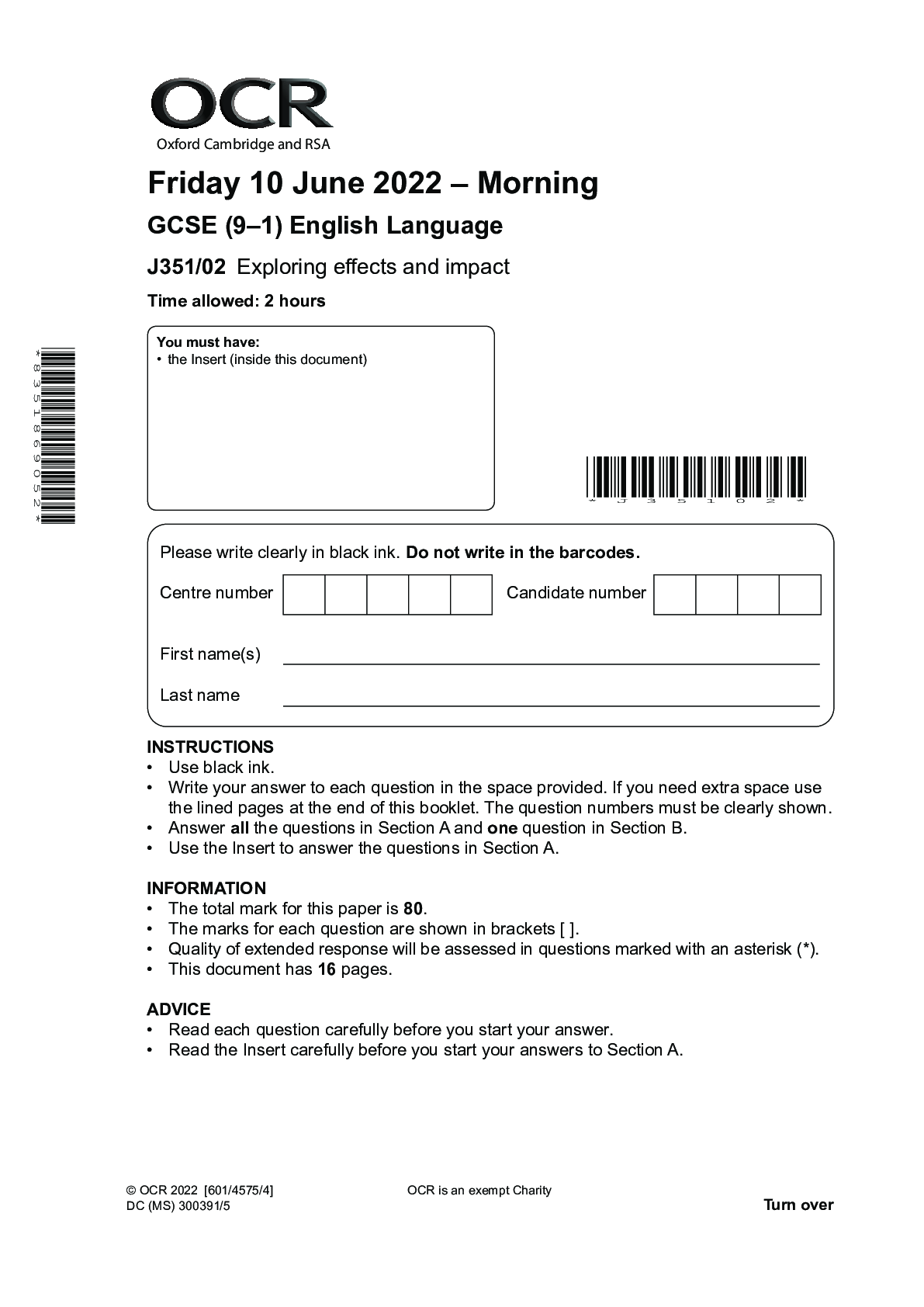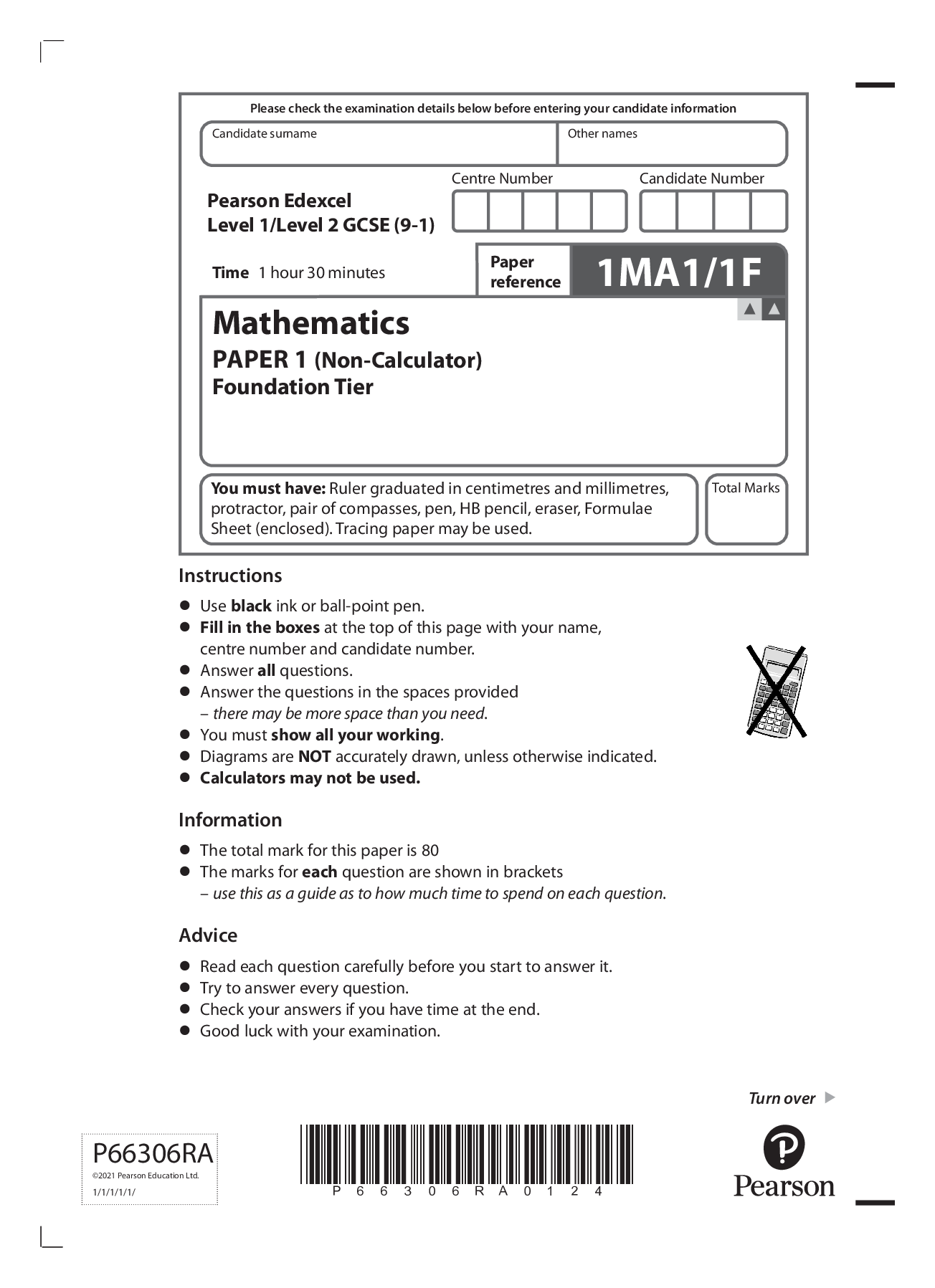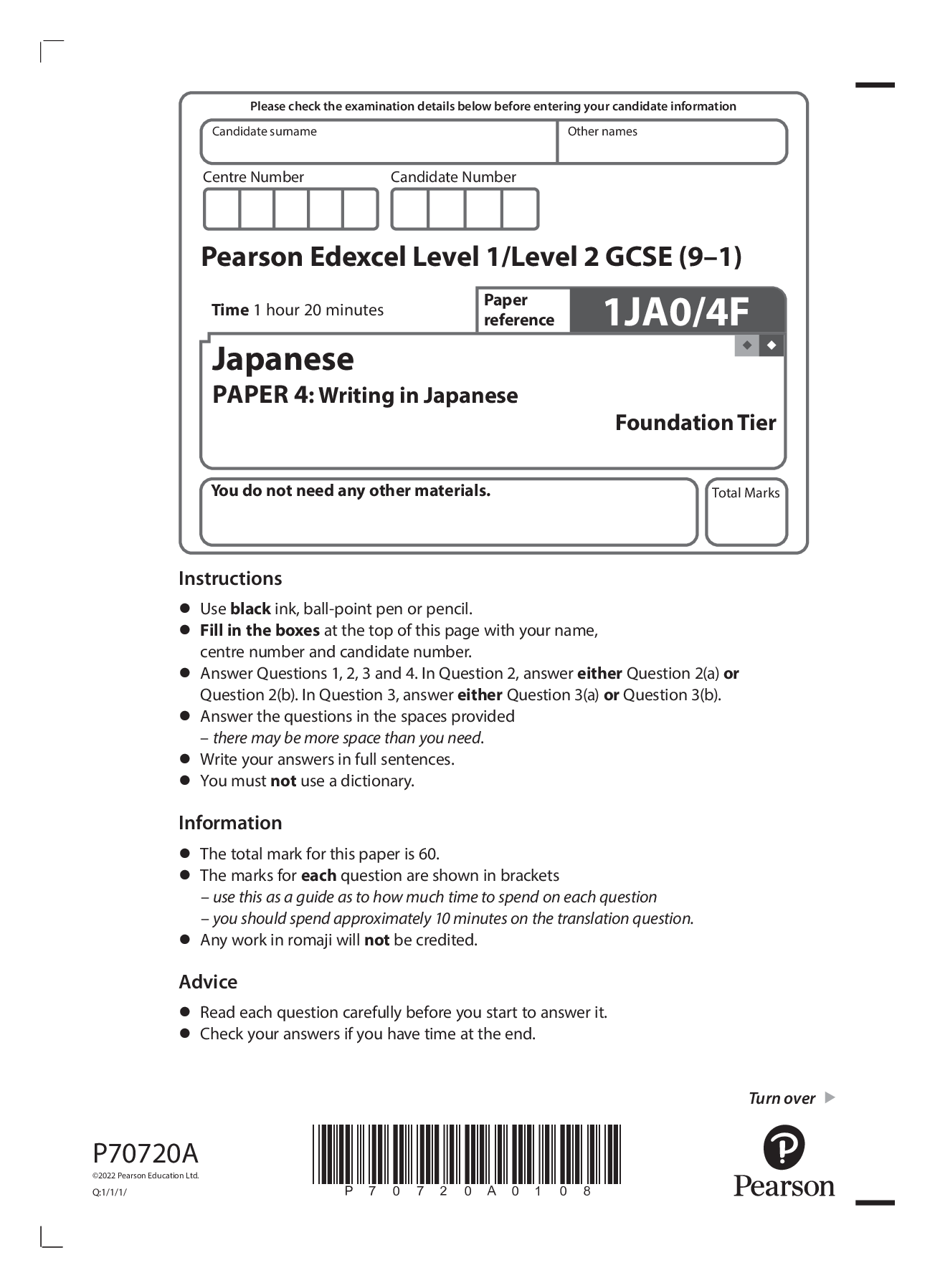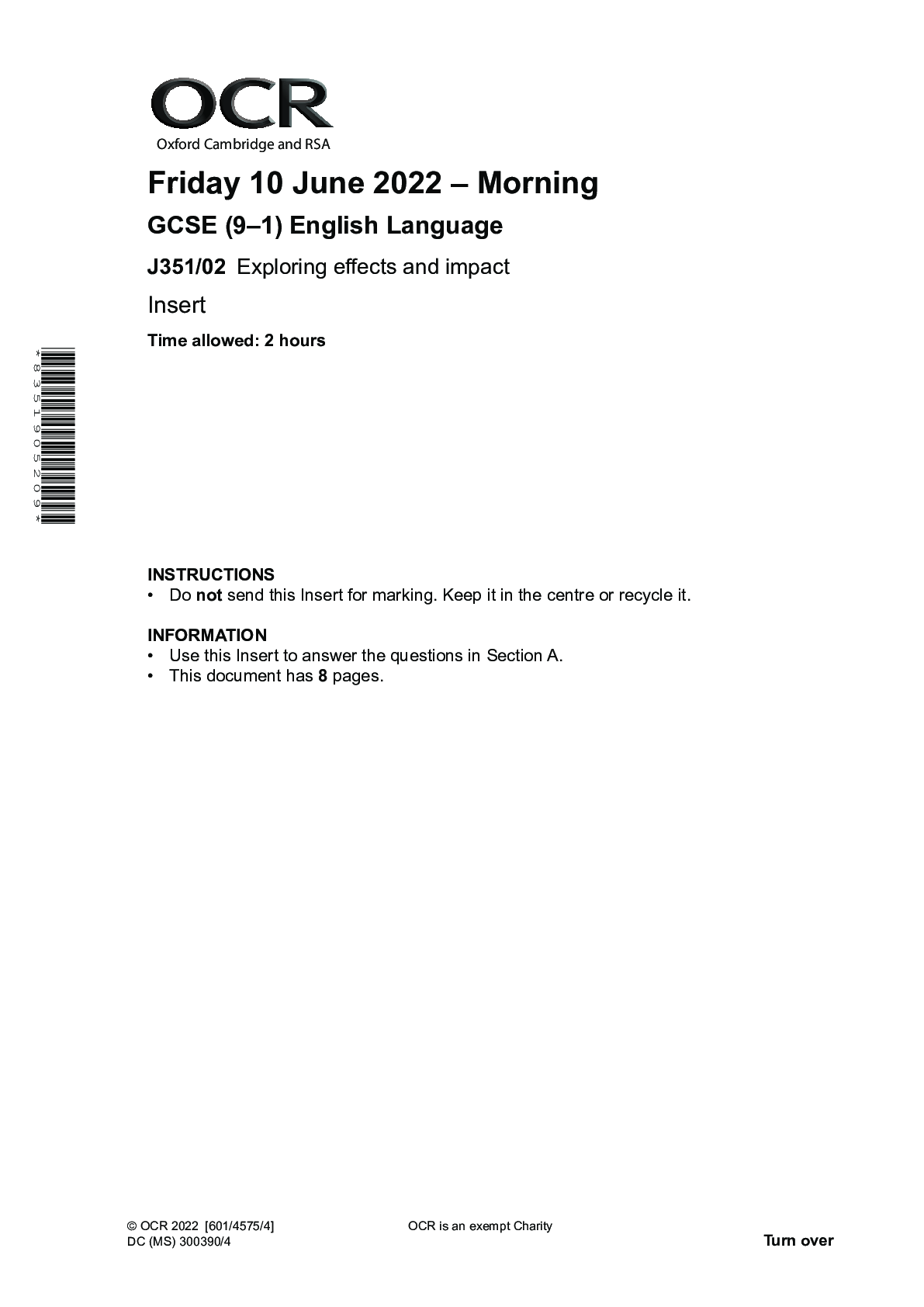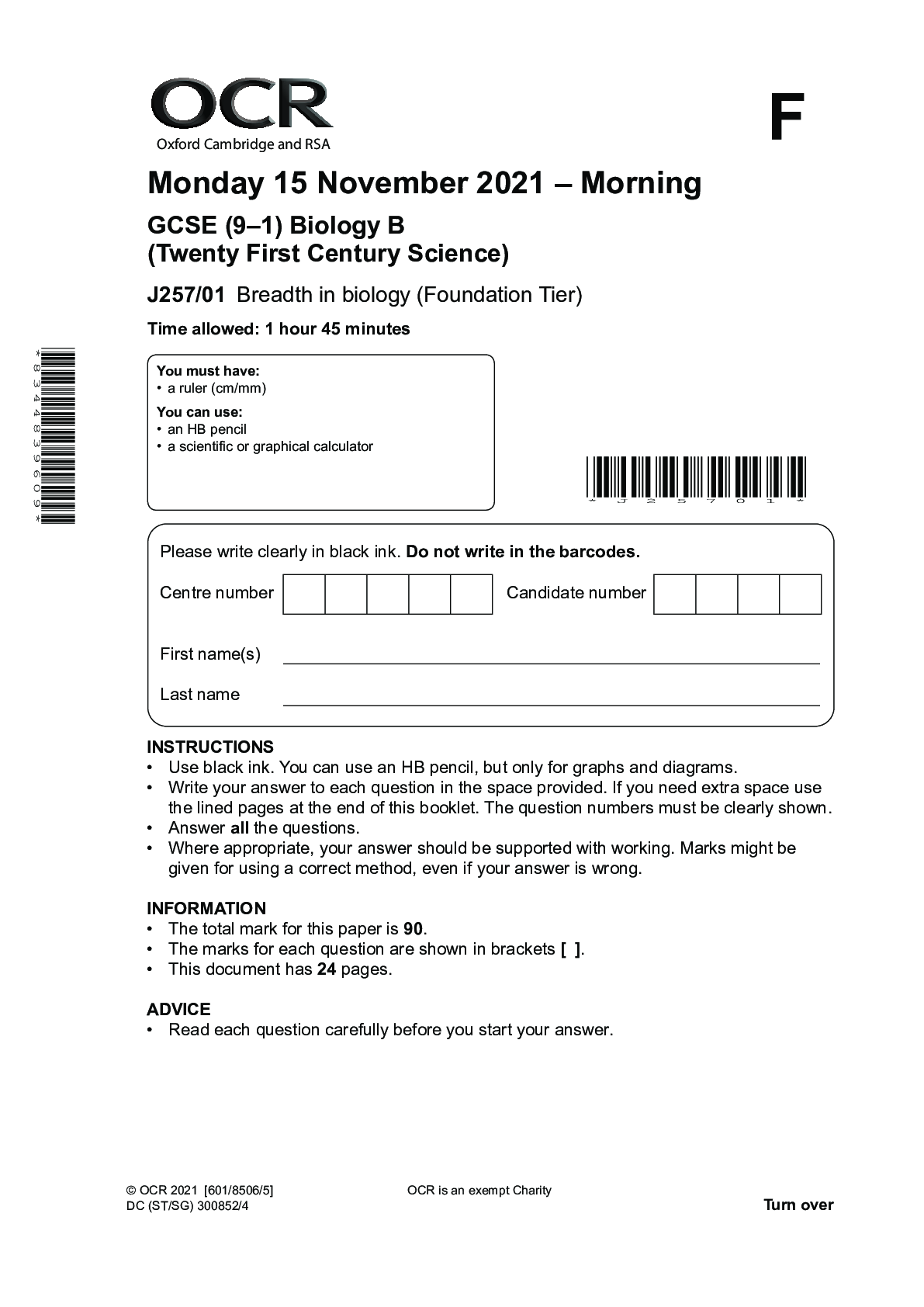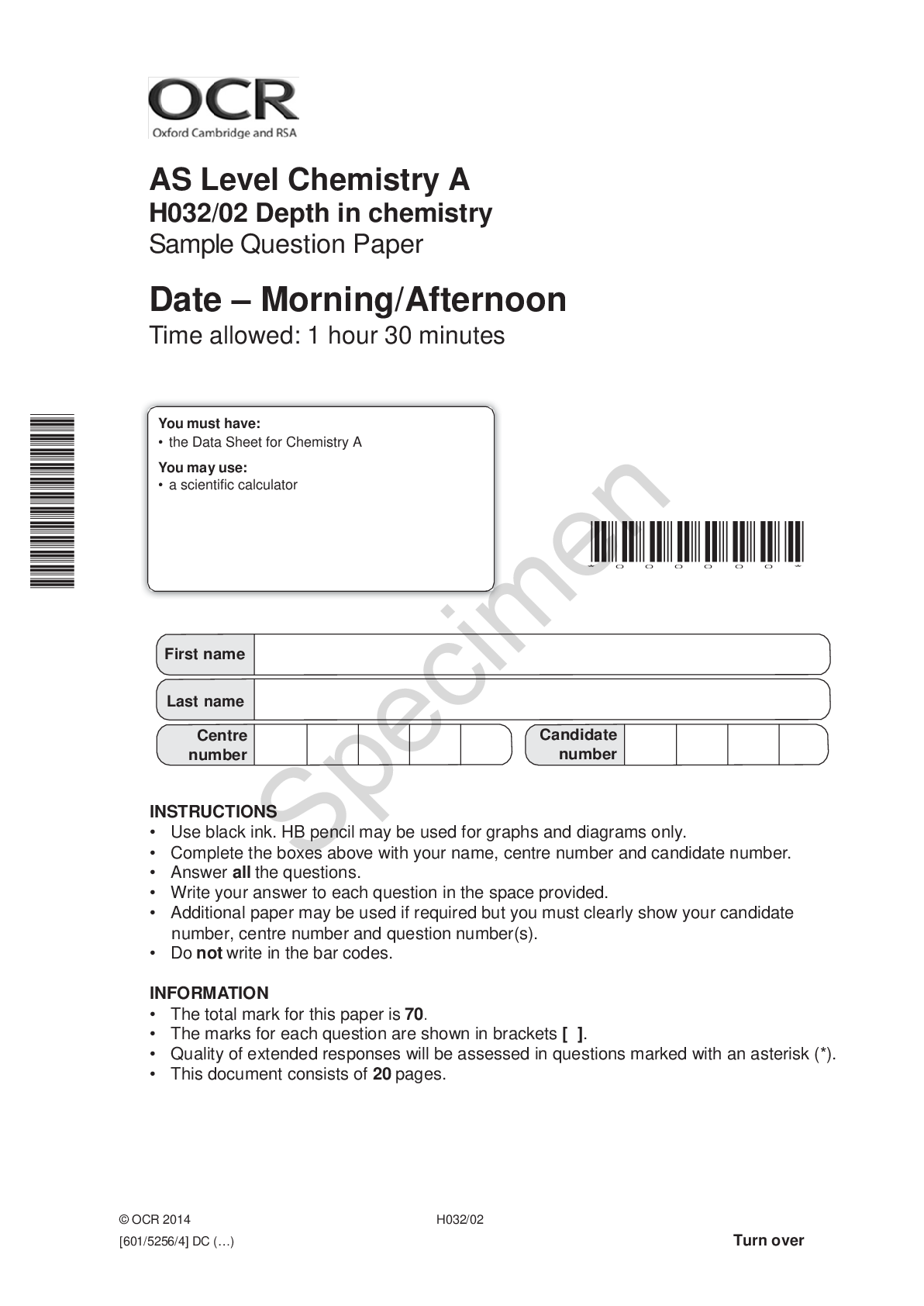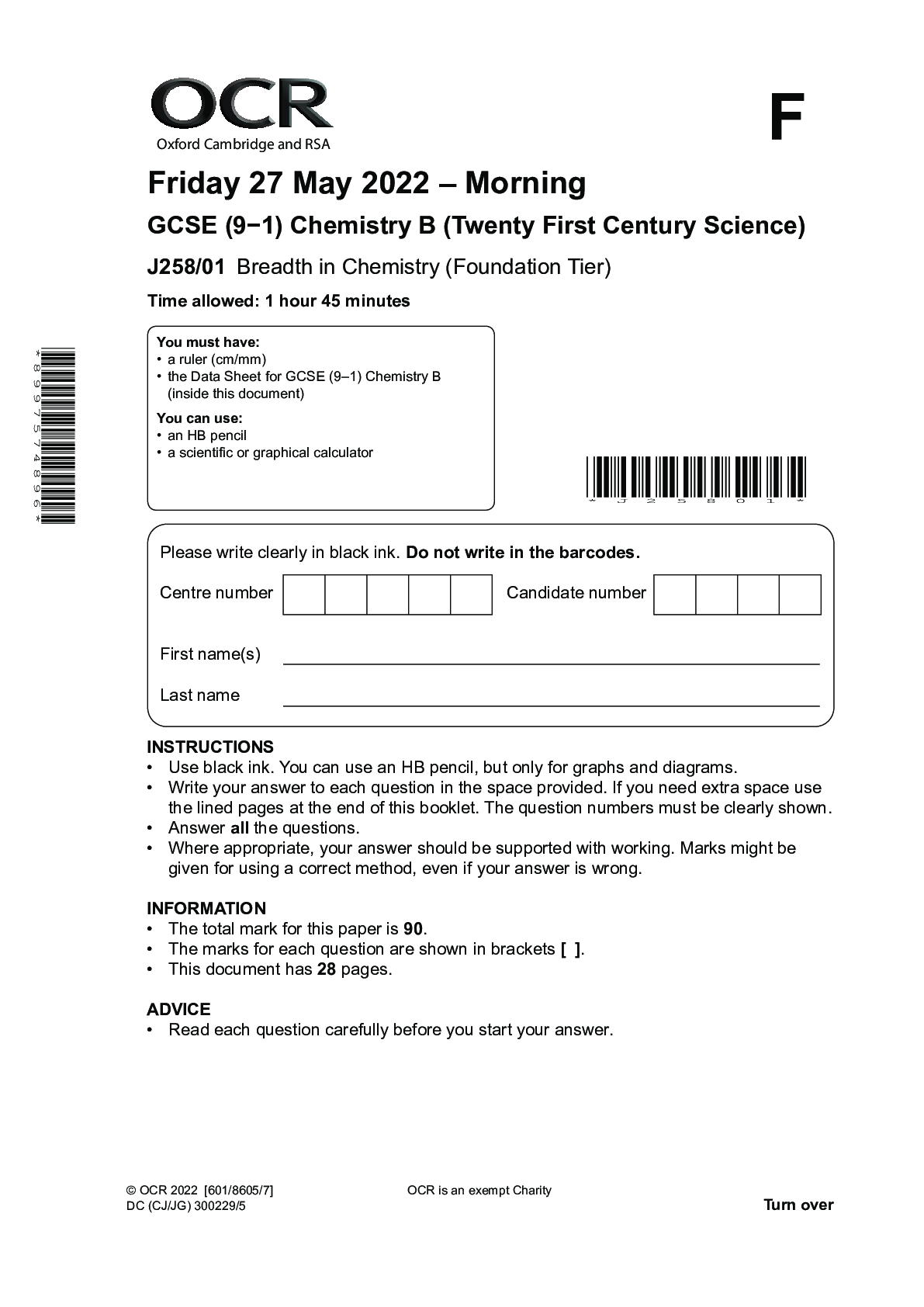Chemistry > QUESTION PAPER (QP) > OCR Oxford Cambridge and RSA Monday 20 June 2022 — Morning GCSE (9—1) Chemistry B (Twenty First (All)
OCR Oxford Cambridge and RSA Monday 20 June 2022 — Morning GCSE (9—1) Chemistry B (Twenty First Century Science) J258102 Depth in Chemistry (Foundation Tier) Time allowed: 1 hour 45 minutes
Document Content and Description Below
INSTRUCTIONS • Use black ink. You can use an HB pencil, but only for graphs and diagrams. • Write your answer to each question in the space provided. If you need extra space use the lined page... s at the end of this booklet. The question numbers must be clearly shown. • Answer all the questions. • Where appropriate, your answer should be supported with working. Marks might be given for using a correct method, even if your answer is wrong. INFORMATION • The total mark for this paper is 90. • The marks for each question are shown in brackets [ ]. • Quality of extended response will be assessed in questions marked with an asterisk (*). • This document has 32 pages. ADVICE • Read each question carefully before you start your answer. You must have: • a ruler (cm/mm) • the Data Sheet for GCSE (9-1) Chemistry B (inside this document) You can use: • a scientific or graphical calculator • an HB pencil *8997745195* *J25802* Monday 20 June 2022 – Morning GCSE (9–1) Chemistry B (Twenty First Century Science) J258/02 Depth in Chemistry (Foundation Tier) Time allowed: 1 hour 45 minutes © OCR 2022 [601/8605/7] DC (ST/SW) 308429/4 2 © OCR 2022 Answer all the questions. 1 Fig. 1.1 shows a model for the arrangement of ions in an ionic compound when it is a solid and when it is a liquid. + – + – + – – + – + – + + – + – + – – + – + – + + + + + + – – – – – + + + + + – – – – melting – ions Solid Liquid Fig. 1.1 (a) Which of the following statements are true only for the solid, which are true only for the liquid and which are true for both? Tick (3) one box in each row. True only for the solid True only for the liquid True for both The ions are close together. The ions are attracted by opposite charges. The ions are in a regular arrangement. The ions can move over each other. [2] 3 © OCR 2022 Turn over (b) Sodium chloride and magnesium chloride are ionic compounds. The melting points of sodium chloride and magnesium chloride are shown in the table. Melting point (°C) Sodium chloride 801 Magnesium chloride 714 (i) What is the state of sodium chloride and of magnesium chloride at 750°C? Put a ring around one word to complete each sentence. At 750°C, sodium chloride is a solid / liquid / gas. At 750°C, magnesium chloride is a solid / liquid / gas. [1] (ii) A limitation of the model shown in Fig. 1.1 is that it does not show the reasons why different compounds have different melting points. Which two statements describe the reasons why compounds have different melting points? Tick (3) two boxes. Ions in different compounds have different chemical symbols. Ions in different compounds have different charges. Ions in different compounds have different colours. The force of attraction between ions is different in different compounds. [2] 4 © OCR 2022 (c) Sodium chloride contains sodium ions, Na+, with a single positive charge. Fig. 1.2 shows the arrangement of electrons in a sodium atom. Na Electron arrangement: 2,8,1 Fig. 1.2 (i) Which information from the Periodic Table shows us that a sodium atom contains a total of 11 electrons? Tick (3) one box. the atomic number the chemical symbol for the element the group number the relative atomic mass [1] (ii) Use ideas about electrons to explain why sodium atoms form an ion with a +1 charge. ........................................................................................................................................... ........................................................................................................................................... ...................................................................................................................................... [2] 5 © OCR 2022 Turn over 2 Jane does an experiment. She puts 10cm3 of copper sulfate solution in a boiling tube. She adds 5cm3 of sodium hydroxide solution. A precipitate of copper hydroxide forms. precipitate forms 10cm3 of copper sulfate solution 5 cm3 of sodium hydroxide solution (a) What are the correct state symbols for copper sulfate and copper hydroxide in this experiment? Tick (3) one box in each row. Substance State symbol (s) (aq) (l) copper sulfate solution copper hydroxide precipitate [2] (b) At the end of the reaction, the boiling tube contains a mixture of a precipitate of copper hydroxide in a solution. Describe how Jane can separate pure, dry copper hydroxide from this mixture. ................................................................................................................................................... ................................................................................................................................................... ................................................................................................................................................... .............................................................................................................................................. [2] 6 © OCR 2022 (c) Jane does more experiments. She adds a different volume of sodium hydroxide solution to 20cm3 of copper sulfate solution each time. She records the mass of dry copper hydroxide that forms in each experiment. Table 2.1 shows her results. Volume of copper sulfate solution (cm3) Volume of sodium hydroxide solution added (cm3) Mass of dry copper hydroxide formed (g) 20 5 0.18 20 10 0.52 20 15 0.58 20 20 0.78 20 25 0.98 20 30 0.98 20 35 0.98 Table 2.1 (i) Describe the pattern shown by the results in Table 2.1. ........................................................................................................................................... ........................................................................................................................................... ...................................................................................................................................... [2] (ii) Jane wants to change her experiment to make more than 1.00g of dry copper hydroxide. Jane and Alex talk about the results. Jane says, ‘To make more copper hydroxide we need to add more than 35cm3 of sodium hydroxide solution.’ Alex says, ‘To make more copper hydroxide we need to add more than 20cm3 of copper sulfate solution.’ Who is right? Jane Alex Use information from Table 2.1 to explain your choice. ........................................................................................................................................... ........................................................................................................................................... ........................................................................................................................................... ...................................................................................................................................... [2] 7 © OCR 2022 Turn over (d) Jane plots her results on a graph. 0 0.00 0.20 0.40 0.60 0.80 1.00 1.20 5 10 15 20 Volume of sodium hydroxide solution added (cm3) Mass of dry copper hydroxide formed (g) 25 30 35 40 Jane thinks that one of her results is an outlier. (i) Draw lines of best fit on the graph. [1] (ii) Put a ring around the outlier on the graph. [1] (iii) Suggest what the correct mass reading for the outlier should be. correct mass reading = ..................................... g [1] (iv) What is the most likely reason for the outlier? Tick (3) one box. Jane did not add enough sodium hydroxide solution. Some of the copper hydroxide was lost before weighing. The copper hydroxide contained water when Jane weighed it. The reaction had not finished. [1] 8 © OCR 2022 3 Beth works for a company that makes hydrogen fuel cells. She measures how much electrical energy a fuel cell produces by measuring its potential difference. She uses the cell shown. V solution of potassium hydroxide (KOH) in water electrodes voltmeter to measure potential difference oxygen (O2) gas in waste out waste out hydrogen (H2) gas in (a) Before she sets up the cell, Beth tests each gas to check its identity. Draw lines to connect each gas to its correct test and result. Gas Test Result [2] hydrogen oxygen lime water glowing splint lighted splint damp pH paper pops goes blue goes milky relights 9 © OCR 2022 Turn over (b) The fuel cell is filled with potassium hydroxide solution rather than pure water. This is because potassium hydroxide solution is a better electrical conductor than pure water. Which statement explains why potassium hydroxide solution is a better electrical conductor than pure water? Tick (3) one box. Potassium hydroxide is acidic. Potassium hydroxide is a metal. Potassium hydroxide is very soluble in water. Potassium hydroxide solution contains charged ions. [1] (c) This equation shows the reaction that happens in the fuel cell: 2H2 + O2 2H2O Beth does some experiments using different amounts of hydrogen in a fuel cell. She records the masses of hydrogen and oxygen which are used and the mass of water made each time. Her results are shown in Table 3.1. Experiment Mass of hydrogen used (g) Mass of oxygen used (g) Mass of water made (g) 1 0.1 0.8 0.9 2 0.4 3.2 3.6 3 0.5 4.0 ........................ 4 1.0 ........................ ........................ Table 3.1 (i) Complete Table 3.1 by predicting the missing amounts for experiments 3 and 4. [2] 10 © OCR 2022 (ii) In each experiment, Beth notices that the potential difference of the cell decreases after a time. Why does this happen? Tick (3) one box. The concentration of potassium hydroxide solution increases. The hydrogen and oxygen are used up. The reaction takes in energy. Waste products are made. [1] (d) Beth’s company wants to use hydrogen fuel cells to provide power for a car. Most cars use petrol as a fuel. Beth looks at the information about hydrogen and petrol in Table 3.2. Hydrogen Petrol Energy released by 1kg of fuel (MJ) 140 50 State at room temperature and pressure gas liquid Volume of 1kg of fuel (m3) 12 0.001 Waste products water carbon dioxide and water Other points usually produced from electrolysis of water which needs electricity petrol engines also produce carbon monoxide and nitrogen oxides Table 3.2 (i) Use information from Table 3.2 to explain two advantages of using hydrogen, rather than petrol, as a fuel for cars. 1 ........................................................................................................................................ ........................................................................................................................................... 2 ........................................................................................................................................ ........................................................................................................................................... [2] 11 © OCR 2022 Turn over (ii) Use information from Table 3.2 to explain two reasons why hydrogen is more difficult to use as a fuel for cars than petrol. 1 ........................................................................................................................................ ........................................................................................................................................... 2 ........................................................................................................................................ ........................................................................................................................................... [2] 12 © OCR 2022 4 The solubility of a salt shows how much salt dissolves in 100g of water. The graph shows the solubility of some Group 1 salts in water at different temperatures. 0 0 10 20 30 40 50 60 10 20 30 40 Temperature (°C) Solubility (g of salt in 100 g of water) 50 60 70 80 sodium chloride potassium chloride (a) Use the graph to describe how temperature affects the solubility of sodium chloride and potassium chloride. Use values from the graph to support your answe [Show More]
Last updated: 2 years ago
Preview 1 out of 32 pages

Buy this document to get the full access instantly
Instant Download Access after purchase
Buy NowInstant download
We Accept:

Reviews( 0 )
$7.00
Can't find what you want? Try our AI powered Search
Document information
Connected school, study & course
About the document
Uploaded On
Apr 03, 2023
Number of pages
32
Written in
Additional information
This document has been written for:
Uploaded
Apr 03, 2023
Downloads
0
Views
152

